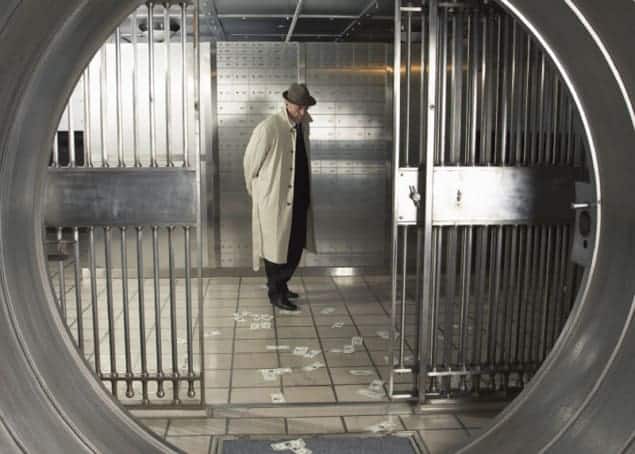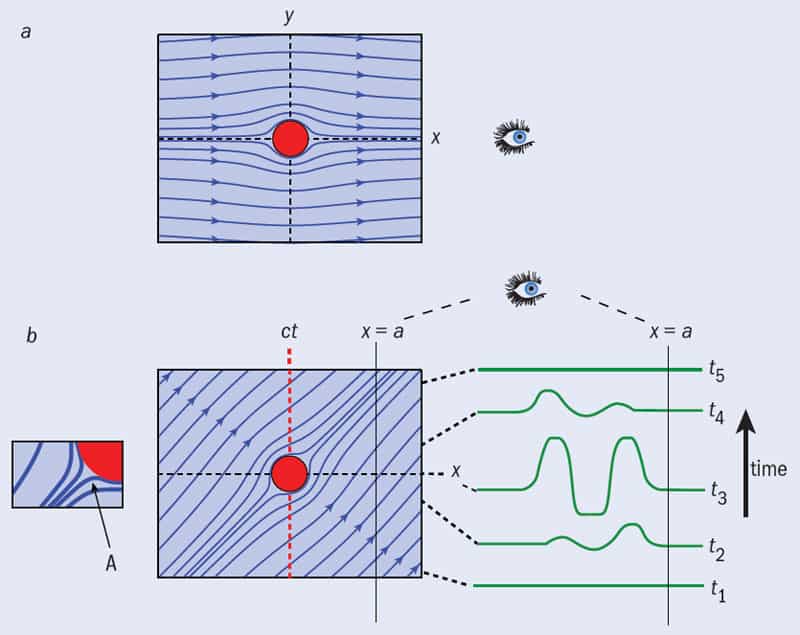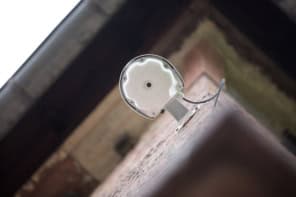Most existing invisibility cloaks are designed to hide objects from view. But as Martin McCall and Paul Kinsler explain, it could also be possible to make "space–time" cloaks that allow selected events to go undetected – perfect for the ultimate bank heist

Our view of the world is determined by what our eyes see, our ears hear and our noses smell, or what the philosopher Bertrand Russell termed “sense data”. But we know from simple optical illusions that our eyes can be fooled – things are not necessarily always what they seem. However, the techniques that physicists have recently developed to manipulate the path taken by light and other electromagnetic radiation are not mere tricks of the eye: they are real advances that can result in some fascinating and useful effects.
By making specially engineered “metamaterials”, we can now create primitive versions of Harry Potter’s invisibility cloak. After diverting light around an object – like water flowing round a tree stump in a river, or cars parting to either side of a traffic island – we can seamlessly reintegrate it afterwards. Our senses are subverted, not by trickery, but because the light reaching our eyes is the same as if the object were not there. By changing the paths of light rays through space to hide an object at a selected location, we are able to make what is called a “spatial cloak”.
But imagine if we could make a cloak that operates not only in space but in time as well. To understand how such a “space–time” cloak might work, consider a bank housing a money-filled safe. Initially, all incoming light continuously scatters off the safe and its surroundings, revealing the rather dull scene of an undisturbed safe visible to surveillance cameras. But imagine, near some specified time, splitting all the light approaching the safe into two parts: “before” and “after”, with the “before” part sped up, and the “after” part slowed down. This would create a brief period of darkness in the stream of illuminating photons. If the photons were a stream of cars on a motorway, it is as if the leading cars were to speed up and those trailing behind were to decelerate, creating a gap in the traffic edged by bunches of cars (a dark period with bright edges – see t3 in figure 1).
Now imagine that during the moment of darkness, a safe-cracker enters the scene and steals the money, being careful to close the safe door before he leaves. With the safe-cracker gone, the process of speeding up and slowing down the light is reversed, leading to an apparently untouched, uniform illumination being reconstituted. As far as the light reaching the surveillance cameras is concerned, everything looks the same as it did beforehand, with the safe door firmly shut. The dark interval when the safe was cracked has literally been edited out of visible history.
To complete our motorway analogy, it is as if the cars have acted to first open up and then close a gap in traffic, leaving no disturbance in the flow of vehicles. There is now no evidence of that temporary car-free interlude, during which the proverbial chicken may even have crossed the road without getting squashed. So by manipulating how light travels in time around a region of space, we can, at least in principle, make a space–time cloak that can conceal events – an “event cloak”, if you will.
Transform and go
Both space and space–time cloaks use a general method called “transformation optics”, whereby cloak designers decide what route they want light to take before calculating what sort of material the light should pass through to achieve that aim. The point is that light rays travel along paths that can be mathematically altered – for example from straight lines to curves. However, to create the desired distortions of the ray paths, we need our material to be carefully designed, a process that is usually expressed in terms of coordinate transformations. We can then use Einstein’s “principle of covariance”, which says that all physical theories are independent of the coordinates used, to calculate the material properties that will produce the desired light trajectories. Whereas regular (i.e. spatial) invisibility cloaks apply this principle only in space (figure 1a), an event cloak applies it in space–time (figure 1b) – after all, time is as much a coordinate as space, with both appearing in Maxwell’s equations for the electromagnetic field.
What is remarkable is that the event cloak leaves the light rays undeviated from their path from source to detector – they do not curve in space, instead they curve in space–time. It is their speed, not direction, that changes as a function of both position and time. But because our proposal is based on speeding light up in some places and slowing it down in others, we have to ensure that the average speed of the light in our material is less than it would be in a vacuum. After all, since nothing can travel faster than light in a vacuum, our method, which involves speeding up part of the light, would otherwise not work. Another important detail is ensuring that the cloaking light rays do not point towards the past. The simple circular space–time cloak of figure 1b, although ideal for explanatory purposes, unfortunately does include such rays. Thankfully, the design can be modified to remove such features.
From dream to reality
It is easy to imagine all sorts of things that could be done with an event cloak – from the big and fanciful to the small and potentially more useful. Making one in practice would, of course, be another challenge entirely. What we would need is a set of parallel metamaterial layers, each containing an array of tiny metallic elements, the conduction electrons in which would interact with light in a way that could be easily controlled. Such tiny elements, or “meta-atoms”, are the usual way of building up the metamaterials used in ordinary spatial cloaks, but what we need is a more adaptable interaction. In particular, we want to be able to independently adjust the response of each layer in the metamaterial as time passes.
Assuming such a material can be made, illuminating light travelling perpendicular to the layers would not “see” a heterogeneous structure, but a smooth effective medium – if, that is, its wavelength is much bigger than both the meta-atoms and the spacing between the metamaterial sheets. However, because of the presence of addressable metallic elements, the average speed of the light through the material can be dynamically adjusted. The metamaterial properties can thus be controlled so that they produce the characteristic dark-spot intensity null of the space–time cloak at the desired space and time.
Events occurring in the cloakable space between the central layers (figure 2a) near the chosen time will occur in the dark, and so be hidden from – and unsuspected by – any observer. Although this dark spot can exist over as long a distance as we like, it moves, and lasts only for a relatively short time that depends on the performance and thickness of the metamaterial. For example, a metre-scale cloaking device would only be able to cloak an interval of a nanosecond or so, while current technological limitations would probably reduce this by a factor of 10 or even 100.
Assuming that a future generation is able to produce a high-performance, macroscopic, fully functioning space–time cloak, one party trick that it could perform would be to create the illusion of a Star Trek-type transporter (figure 2b). What we would need to do is take our metamaterial cloak made from meta-atoms much smaller in size than the wavelength of light and carve a central corridor down the middle. As the null in the illuminating light passes over the central region, someone could run in the dark from one end (A) of the corridor to the other (B). But as far as any outside observer is concerned, it would appear as if the person had instantly relocated from A to B in true Star Trek style.
More plausibly, consider an experiment that cloaks a small box containing excited atoms (figure 2c). The atoms will spontaneously decay, emitting photons according to the usual exponential Poisson statistics. However, the light emitted by the atoms as the intensity null passes over the box is affected by the closing of the cloak. What this means is that any light emitted during the cloaked interval is compressed into a much shorter time period, escaping the cloak as a brief but intense flash of light. This phenomenon is more than just of abstract interest because it could be the first ever experimental signature produced by a working space–time cloak.
Finally, a space–time cloak could be used to control the flow signals in an optical routing system (figure 2d), where one node might need to receive and process signals simultaneously from different channels. For example, one channel might be a clock signal that the external circuit demands is never interrupted, while the other channel may contain data that nevertheless must be processed as a priority. This conflict could be resolved by a space–time cloak that briefly opens up a gap in the clock signal. The node could process the priority bits during the gap, and then seamlessly reconstitute the clock signal by closing the cloak. This would enable an “interrupt-without-interrupt” operation that might be useful in quantum computing, which inherently deals with correlated data channels.
Practical questions
Although mathematics can tell us the precise electromagnetic properties required of a space–time cloak, actually making such a device is well beyond current metamaterials technology. For example, the material has to be able to couple the electric and magnetic fields in a specific way. What is surprising is that this exotic coupling has the side effect of making it appear to the light as though the medium is in motion, despite remaining stationary. If, however, we are content with making an imperfect space–time cloak, then such a device does lie within the range of current technology and would involve building the cloak from optical fibre. We estimate that an event cloak in 3 km-long fibre with a 1 km-long opening section, a 1 km long operating section and a 1 km-long closing section, could obscure events lasting up to several nanoseconds.
Optical fibres are potential candidates because their refractive index can be increased simply by raising the intensity of the beam they carry, thereby slowing the light as required. This could be done by suddenly increasing the intensity of a “control” beam, with the resulting intensity step-change travelling down the fibre and inducing a travelling change in light speed. If the fibre also contained a second, constant, “monitor” beam, photons in that beam would travel faster than the control beam before the intensity increase, but more slowly afterwards – exactly what is needed to open the dark interval in our space–time cloak.
We could then transfer this monitor beam into another fibre with a new control beam that this time suddenly decreases in intensity. This reverses the previous speed differential, closing down the dark interval, and recreating the original unvarying monitoring light beam. To return to our motorway analogy, it is as if the intense part of the control beam is a shower of rain moving along with part of the traffic, forcing only those drivers to slow down. The gap in traffic opens when the trailing cars are rained on and slow down, and closes when the rain shower switches to instead drench the leading cars, making them slow down as the trailing cars speed up.
In practice, such a cloak would be imperfect because we are only able to modify the electrical properties of the fibres, since they are non-magnetic. This imperfection leads to stray reflections, allowing the cloak to be detected. To remove all reflections we would have to modify both electric and magnetic properties. Fortunately, though, the details of what was going on inside the cloak would still remain hidden.
The road ahead
Although lots of researchers around the world are trying to make spatial cloaks – in some cases with a good deal of success – no-one has yet tried to demonstrate a space–time cloak in the lab. However, there seems to be no obvious reason why such a cloak – and an experimental signature confirming it, such as the atoms-in-the-box test – could not be achieved quite soon, perhaps even within a few years. Once the principle has been shown, we can then start looking into applications along the lines suggested above, particularly the idea of being able to use an event cloak to resolve computational conflicts in optical processing systems.
Ultimately, it may even be possible for the operation of a space–time cloak to be triggered by events preceding those to be hidden by the device. One possible downside, though, is that covert processing and computation could then be instigated by rogue data infiltrating a system, without the system ever being aware that it had been hacked. To return to our analogy of a chicken crossing the road through a gap in the traffic, it is as if a particularly devious and clever chicken actually choreographs the whole routine beforehand by manipulating the speed limits (to open up the gap) and then again after crossing (to close it again). So while we may never know why the chicken crossed the road, at least we can imagine how it did it.






